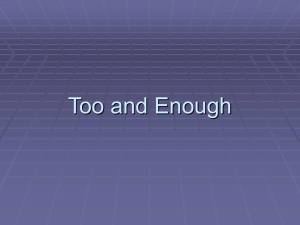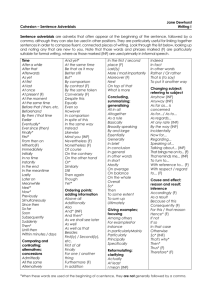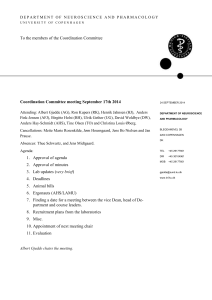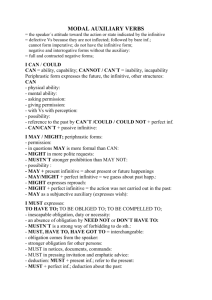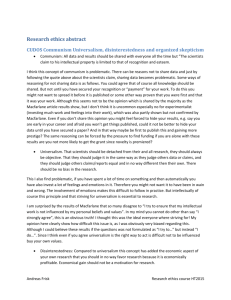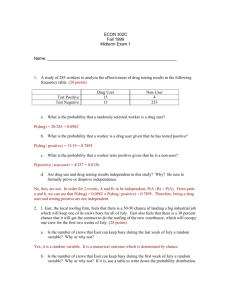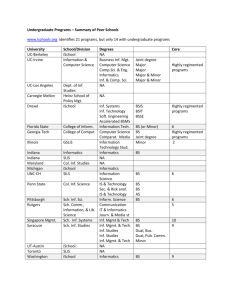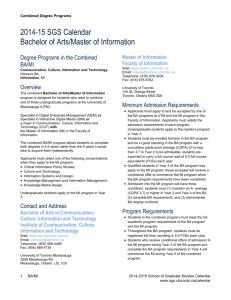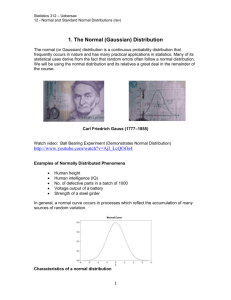Merton, accountability and the sociolinguistic study of
advertisement
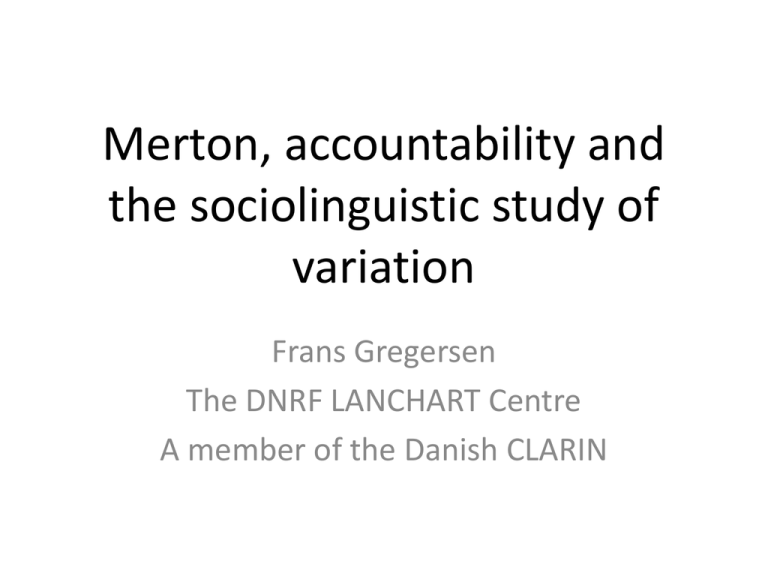
Merton, accountability and the sociolinguistic study of variation Frans Gregersen The DNRF LANCHART Centre A member of the Danish CLARIN PART I INTRO ON THE SOCIOLOGY OF SCIENCE Robert K. Merton 1942 • The sociology of science: • The need to scrutinize the ethos of science became pressing in 1942 in the face of the Nazi denial of rationalism The CUDOS norms • Communism – the common ownership of scientific discoveries, according to which scientists give up intellectual property in exchange for recognition and esteem. • Universalism – according to which claims to truth are evaluated in terms of universal or impersonal criteria, and not on the basis of race, class, gender, religion, or nationality; • Disinterestedness – according to which scientists are rewarded for acting in ways that outwardly appear to be selfless; • Organized skepticism – all ideas must be tested and are subject to rigorous, structured community scrutiny The natural sciences and the CUDOS norms • Communism: the need for collective work and division of labour, the praxis of big science • Universalism: Natural sciences are more universal and less bound to local languages, traditions and culture than the human sciences • Disinterestedness: sharing results • Organized skepticism: double blind peer review systems, evaluation procedures The human sciences and CUDOS • Communism: More individual researchers than groups; prototypically little science • Universalism: Human sciences less universal and more bound to local languages, traditions and cultures than the natural sciences • Disinterestedness: Often the individual is tied to the method and results • Organized skepticism: More skepticism than organization Part II THE LANCHART PROJECT The LANCHART Centre • Established 2005 by a grant from the Danish National Research Foundation to Frans Gregersen • Will last at least until May 2013 and hopefully two years longer • Repeats previous studies of Danish spoken language at six sites from all over Denmark by re-recording informants The LANCHART Sites In Jutland: Vinderup 1973, 1978 and 2006 Odder 1986-87 and 2005 On Funen: Vissenbjerg 1980-84 and 1999-2000 On Zealand: Næstved 1986-89 and 2005-6 Næstved 1986-90 and 2005-07 Køge 1989-98 and 2006-08 København (Copenhagen) 1986-88 and 2006-10 The Copenhagen data set • 42 informants in total: • 24 in generation 1 (born 1944-62) interviewed first time in 1986-88 (OLD recordings), second time in 2006-08 (NEW recordings), 6 in each cell: Middle Class (MC), Working Class (WC), males (m) and females (f) • 18 in generation 2 (born 1963-73); 4 in the two WC groups and 5 in the two MC groups; OLD and NEW recordings Technically speaking… • All transcription is done using the Transcriber programme • All files are then stored as Praat text grids since Praat allows any number of tiers for coding; tiers are tied to the orthography • Information about the informants is stored in a separate mySQL data base using the ID no. as the cue • The search engine connects the informant data base and the orthographical tier Part III THE VARIABLE The variable [ɛ] > [e]_[ŋ] • The raising of the [ɛ] before the velar nasal may be operationalized as follows: Three values: • Original (standard) value: [ɛ] • Raised variant: [e] • An in-between variant which is heard as neither identical to [e] or [ɛ]: in-btw. • penge (money) realized as [peŋə] or [pɛŋə] Method • Auditory coding by two independent coders; any discrepancy is solved by a third person, the checker • In principle forced choice, either [e] or [ɛ] but in practice the coders felt the need for the inbtw. value as well Part IV RESULTS The generation 1 results: Gender (N= 689) Gender in the NEW recordings (N= 74) The generation 2 results: gender (N=396) Gender in the NEW recordings (N=447) The generation 1 groups The generation 2 groups Individual differences in real time The WC women's pattern in OLD and NEW recordings compared 100% 90% 80% ɛ 70% in-btw. 60% e 50% ɛ 40% in-btw. 30% e 20% 10% 0% Inf 1 Inf 1 Inf 2 Inf 2 Inf 3 Inf 3 Inf 4 Inf 4 Inf 5 Inf 5 Inf 6 Inf 6 OLD NEW OLD NEW OLD NEW OLD NEW OLD NEW OLD NEW Part V DISCUSSION Linguistic points • The status of the in-between variant: [ɛ] as the standard variant and everything else as raising - or three distinct values with their separate stories? • Is this stable variation or variation with a direction (a change) and if so how old is it? • Is this lexical diffusion and if so from which part of the lexicon? Lexical diffusion or morphophonology? • ’penge’, money (no relation to modern word forms with any [a]) vs. ’længe’, (for long, adv.) with a connection to the word ’lang’, long [e] in- btw. [ɛ] ’længe’ 28 29 248 ’penge’ 200 101 448 • Chi square: 48.7 p< 0.000 Accountability • It is uniquely retrievable which variant was coded where in the data • The data may be re-analyzed by others • PROBLEM: confidentiality • Thus all data are in principle – if stored as part of the project – available for inspection by others – the norms of communism and organized skepticism may be applied Thanks • To the CLARIN Denmark partners for collaboration, in particular WP3 on spoken language • • • • To the DNRF for the grant Last but not least: To you the public for listening! See you at: www.lanchart.dk
